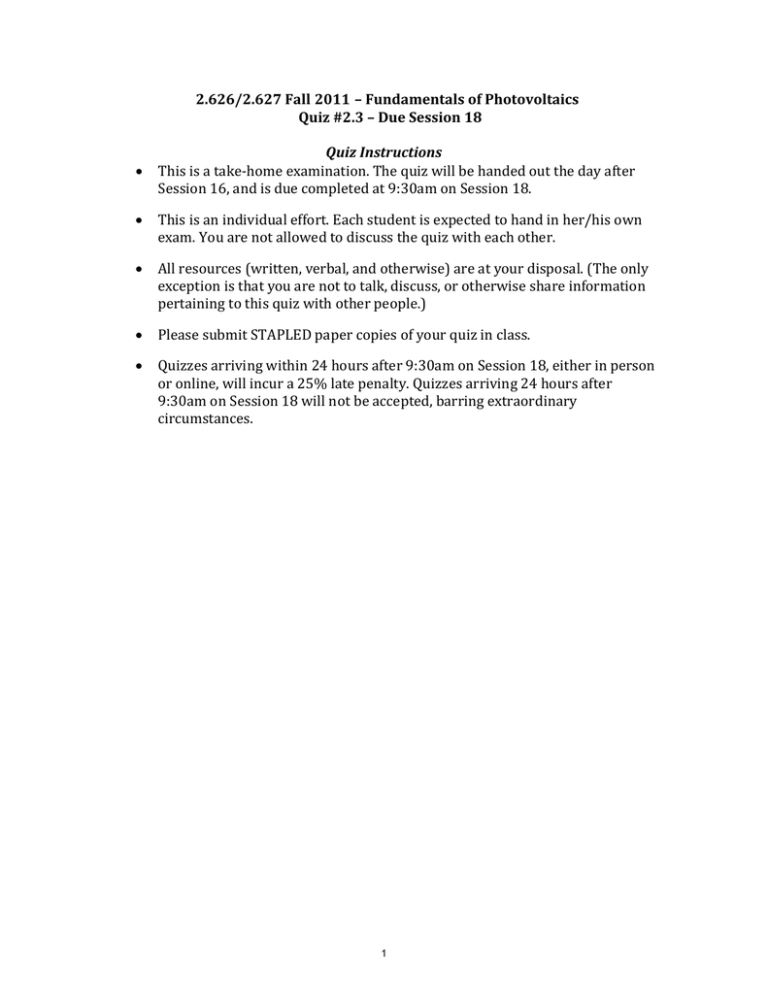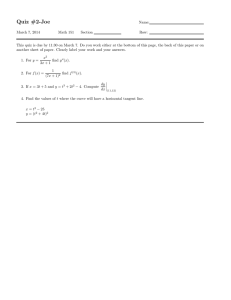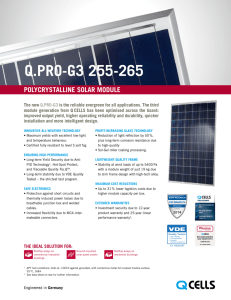2.626/2.627 Fall – Fundamentals of Photovoltaics 2011 Quiz #2.3 – Due Session 18
advertisement

2.626/2.627 Fall 2011 – Fundamentals of Photovoltaics Quiz #2.3 – Due Session 18 • • • • • Quiz Instructions This is a take-home examination. The quiz will be handed out the day after Session 16, and is due completed at 9:30am on Session 18. This is an individual effort. Each student is expected to hand in her/his own exam. You are not allowed to discuss the quiz with each other. All resources (written, verbal, and otherwise) are at your disposal. (The only exception is that you are not to talk, discuss, or otherwise share information pertaining to this quiz with other people.) Please submit STAPLED paper copies of your quiz in class. Quizzes arriving within 24 hours after 9:30am on Session 18, either in person or online, will incur a 25% late penalty. Quizzes arriving 24 hours after 9:30am on Session 18 will not be accepted, barring extraordinary circumstances. 1 Introduction The past week we spent analyzing the cells we had made in the previous week. This quiz aims at dissecting and understanding any performance-limiting aspects of our cells. Additionally we’ll ask what you would do to improve this cell process for future 2626’ers! Question 1 Plot both your dark and illuminated J-V curve on the same curve, and use units of mA/cm2 and Volts. Unless your cell was broken, you can estimate your area as 25cm2. Please state assumed area! Please label axes with proper units. Question 2 Please report the following quantities: - Fill Factor - Open-circuit voltage [V] - Short Circuit Current [mA] - Short Circuit Current Density [mA/cm2] - Efficiency - Maximum power point (Vmpp Impp) Question 3 In Quiz 2.2, you used approximate values for series and shunt resistance to estimate their respective power losses and determine what the most detrimental losses to your system was. Based on your chosen analysis technique, please answer the following: - Suns VOC: o Please plot the ideal I-V curve produced by the Suns VOC tool and your illuminated I-V curve on the same plot. For this analysis please use mA and Volts. o Estimate the power loss due to series resistance based on your Suns VOC measurement. o How does calculated series resistance losses (from the I-V curve fitting completed on quiz 2.2) compare to the your estimate found here? What might account for this difference? o What do you think lead to the high series resistance? - Lock-In Thermography: o Where do the shunts occur on your device? o What are the most likely ways a device gets shunted? o What do you think caused the shunts on your device? Question 4 Now that you’ve seen the process of making solar cells, please answer the following: - Please comment on the relative variability of the KOH etch, POCl diffusion, screen printing, and contact firing. Where do you think the most variability came from in this process? 2 - How would you reduce variability in the fabrication process? If you made the changes you suggested above, would you change your original selection of emitter depth, or finger spacing? Why or why not? Question 6 If cells #32 and #36 were placed in series in a mini-module, please answer the following: - What is the maximum power point of each individual cell? Please give Vmpp, Impp, and Pmpp. - What is maximum power point of the module? Please give Vmpp, Impp, and Pmpp. - What power loss (in W and in %) due to mismatch (i.e. the difference between the two operating individually and in series?) Question 7 If you were to add a SiNx ARC to your cell, please provide a rough numerical estimate of how it would affect the following: - Short-circuit current? - Open-circuit voltage? - Efficiency? - *NOTE: no numerical integration required for this problem, average values of reflectance may be used! 3 MIT OpenCourseWare http://ocw.mit.edu 2.627 / 2.626 Fundamentals of Photovoltaics Fall 2013 For information about citing these materials or our Terms of Use, visit: http://ocw.mit.edu/terms.




